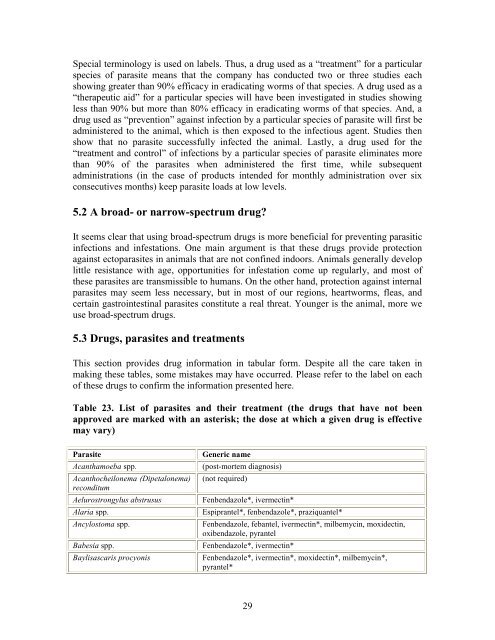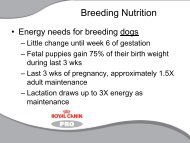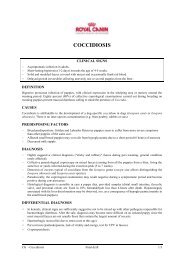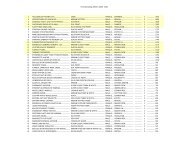Guide to Preventing Parasites.pdf - Royal Canin Canada
Guide to Preventing Parasites.pdf - Royal Canin Canada
Guide to Preventing Parasites.pdf - Royal Canin Canada
You also want an ePaper? Increase the reach of your titles
YUMPU automatically turns print PDFs into web optimized ePapers that Google loves.
Special terminology is used on labels. Thus, a drug used as a “treatment” for a particular<br />
species of parasite means that the company has conducted two or three studies each<br />
showing greater than 90% efficacy in eradicating worms of that species. A drug used as a<br />
“therapeutic aid” for a particular species will have been investigated in studies showing<br />
less than 90% but more than 80% efficacy in eradicating worms of that species. And, a<br />
drug used as “prevention” against infection by a particular species of parasite will first be<br />
administered <strong>to</strong> the animal, which is then exposed <strong>to</strong> the infectious agent. Studies then<br />
show that no parasite successfully infected the animal. Lastly, a drug used for the<br />
“treatment and control” of infections by a particular species of parasite eliminates more<br />
than 90% of the parasites when administered the first time, while subsequent<br />
administrations (in the case of products intended for monthly administration over six<br />
consecutives months) keep parasite loads at low levels.<br />
5.2 A broad- or narrow-spectrum drug?<br />
It seems clear that using broad-spectrum drugs is more beneficial for preventing parasitic<br />
infections and infestations. One main argument is that these drugs provide protection<br />
against ec<strong>to</strong>parasites in animals that are not confined indoors. Animals generally develop<br />
little resistance with age, opportunities for infestation come up regularly, and most of<br />
these parasites are transmissible <strong>to</strong> humans. On the other hand, protection against internal<br />
parasites may seem less necessary, but in most of our regions, heartworms, fleas, and<br />
certain gastrointestinal parasites constitute a real threat. Younger is the animal, more we<br />
use broad-spectrum drugs.<br />
5.3 Drugs, parasites and treatments<br />
This section provides drug information in tabular form. Despite all the care taken in<br />
making these tables, some mistakes may have occurred. Please refer <strong>to</strong> the label on each<br />
of these drugs <strong>to</strong> confirm the information presented here.<br />
Table 23. List of parasites and their treatment (the drugs that have not been<br />
approved are marked with an asterisk; the dose at which a given drug is effective<br />
may vary)<br />
Parasite Generic name<br />
Acanthamoeba spp. (post-mortem diagnosis)<br />
Acanthocheilonema (Dipetalonema)<br />
reconditum<br />
(not required)<br />
Aelurostrongylus abstrusus Fenbendazole*, ivermectin*<br />
Alaria spp. Espiprantel*, fenbendazole*, praziquantel*<br />
Ancylos<strong>to</strong>ma spp. Fenbendazole, febantel, ivermectin*, milbemycin, moxidectin,<br />
oxibendazole, pyrantel<br />
Babesia spp. Fenbendazole*, ivermectin*<br />
Baylisascaris procyonis Fenbendazole*, ivermectin*, moxidectin*, milbemycin*,<br />
pyrantel*<br />
29







